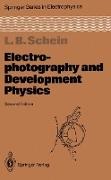Share
Fr. 69.00
Lawrence B Schein, Lawrence B. Schein
Electrophotography and Development Physics
English · Paperback / Softback
Shipping usually within 1 to 2 weeks (title will be printed to order)
Description
Electrophotography and Development Physics focuses on the
complicated and increasingly important technology found in
photocopiers and laser printers. An introduction chapter
acquaints the reader with the technical history of
electrophotography, its current and projected markets, and
also alternative related copying and printing technologies.
A concise descriptionof the physics of the complete
electrophotgraphic process is followed by an in-depth
treatment of static electricity. The three types of
developmentsystems (two component, monocomponent, and
liquid), and their associated charging mechanisms. In this
second edition, a discussion of the new color copiers and a
chapter updating the original material have been added. On
mastering this material, which is presented in a manner
suitable for both the newcomer and the established expert,
the reader will have a workingknowledge of the
electrophotographic process and a detailed knowledge of its
important subsystem, development.
List of contents
1. Introduction.- 1.1 Technical History.- 1.2 Copier Market.- 1.3 Printer Market.- 1.4 Alternative Powder Marking Technologies.- 1.4.1 Magnetography.- 1.4.2 Ionography.- 2. The Electrophotographic Process.- 2.1 The Six Steps of Electrophotography.- 2.1.1 Charge.- 2.1.2 Expose.- 2.1.3 Develop.- 2.1.4 Transfer.- 2.1.5 Fuse.- 2.1.6 Clean.- 2.2 Implementation-Interactions.- 2.3 Subsystem Choices.- 2.3.1 Photoreceptor.- 2.3.2 Charge.- 2.3.3 Light Source.- 2.3.4 Develop.- 2.3.5 Transfer.- 2.3.6 Fuse.- 2.3.7 Clean.- 3. The Development Step.- 3.1 Challenges.- 3.2 Focus.- 3.3 Descriptions.- 4. Toner Charging for Two Component Development Systems.- 4.1 Metal-Metal Contact Charging.- 4.2 Metal-Insulator Contact Charging.- 4.2.1 Controversies.- 4.2.2 Experimental and Theoretical Difficulties.- 4.2.3 Other Metal-Insulator Experiments.- 4.2.4 Electron Transfer Theories.- 4.2.5 Ion Transfer Theories.- 4.3 Insulator-Insulator Contact Charging.- 4.4 Toner-Carrier Charging.- 4.4.1 Surface State Theory.- 4.4.2 Carbon Black.- 4.4.3 Charge Control Agents.- 4.4.4 Charge Measuring Tools.- 4.5 Summary.- 5. Cascade Development.- 5.1 Development Mechanisms.- 5.1.1 Airborne.- 5.1.2 Contact.- 5.1.3 Scavenging.- 5.1.4 Electrode Source.- 5.2 Experimental Work.- 5.2.1 Solid Area Development.- 5.2.2 Line Development.- 5.2.3 Background Development.- 5.3 Theory Ill.- 5.3.1 Airborne Development Ill.- 5.3.2 Contact Development.- 5.4 Summary.- 6. Insulative Magnetic Brush Development.- 6.1 Qualitative Comparison of Development Mechanisms.- 6.2 The Electric Field.- 6.2.1 Charges.- 6.2.2 Effective Dielectric Constant.- 6.3 Theories of Solid Area Development.- 6.3.1 Neutralization.- 6.3.2 Field Stripping.- 6.3.3 Powder Cloud.- 6.3.4 Equilibrium.- 6.3.5 Depletion.- 6.3.6 Complete Theory.- 6.4 Solid Area Development Experiments.- 6.5 Line Development.- 6.6 Background Development.- 6.7 Improvements.- 6.8 Summary.- 7. Conductive Magnetic Brush Development.- 7.1 Initial Theoretical Ideas.- 7.2 Experimental Data and Discussions.- 7.3 Infinitely Conductive Theory.- 7.4 Comparison with Experiment.- 7.5 Line Development.- 7.6 Background Development.- 7.7 Summary.- 8. Toner Charging for Monocomponent Development Systems.- 8.1 Induction Charging.- 8.2 Injection Charging.- 8.3 Contact Charging.- 8.4 Corona Charging.- 8.5 Charging Methods for Powder Coating.- 8.6 Other Charging Methods.- 8.7 Traveling Electric Fields.- 9. Monocomponent Development.- 9.1 Aerosol or Powder Cloud Development.- 9.2 Early Work.- 9.3 Theory of Monocomponent Development.- 9.4 Conductive Toner.- 9.5 Magnetic, Insulative Toner.- 9.6 Nonmagnetic, Insulative Toner.- 9.7 Summary.- 10. Liquid Development.- 10.1 Material Requirements.- 10.1.1 Toner Charging.- 10.1.2 Liquid Properties.- 10.2 Development Theories.- 10.2.1 First-Order Effects.- 10.2.2 Complexities.- 10.2.3 Better Development Theories.- 10.3 Toner Characteristics.- 10.3.1 Optimized Properties.- 10.3.2 Determination of Toner Properties.- 10.4 Recent Developments.- 10.5 Summary.- 11. Color Electrophotography.- 11.1 History.- 11.2 Image Quality.- 11.2.1 Grayscale.- 11.2.2 Other Challenges.- 11.3 Colored Toner Accumulation.- 11.4 New Development Systems.- 11.4.1 Image Quality.- 11.4.2 Compactness.- 11.4.3 Noncontact, Noninteracting Development System.- 11.5 Color Market.- 11.6 Current Copier Products.- 11.7 Current Printer Products.- 12. Update of Chapters 1 10.- 12-1.2 Copier Market.- 12-1.3 Printer Market.- 12-1.4 Alternative Powder Marking Technologies.- 12-1.4.1 Magnetography.- 12-1.4.2 Ionography.- 12-2.1.4 Transfer and Toner Adhesion.- 12-2.3.2 Charge.- 12-2.3.5 Transfer.- 12-2.3.7 Clean.- 12-4 Toner Charging for Two Component Development Systems.- 12-4.3 Insulator-Insulator Contact Charging.- 12-4.4 Toner-Carrier Charging.- 12-4.4.1 Surface State Theory.- 12-4.4.3 Charge Control Agents.- 12-4.4.4 Charge Measuring Tools.- 12-4.4.5 Life Characteristics.- 12-6.2.2 Effective Dielectric Constant.- 12-6.4 Solid Area Development Experiments.- 12-6.6
Product details
| Authors | Lawrence B Schein, Lawrence B. Schein |
| Publisher | Springer, Berlin |
| Languages | English |
| Product format | Paperback / Softback |
| Released | 01.01.1992 |
| EAN | 9783540558583 |
| ISBN | 978-3-540-55858-3 |
| No. of pages | 363 |
| Weight | 552 g |
| Illustrations | 65 SW-Abb., |
| Series |
Springer Series in Electrophysics Springer Series in Electronics and Photonics Springer Series in Electrophysics |
| Subject |
Natural sciences, medicine, IT, technology
> Technology
> Mechanical engineering, production engineering
|
Customer reviews
No reviews have been written for this item yet. Write the first review and be helpful to other users when they decide on a purchase.
Write a review
Thumbs up or thumbs down? Write your own review.

